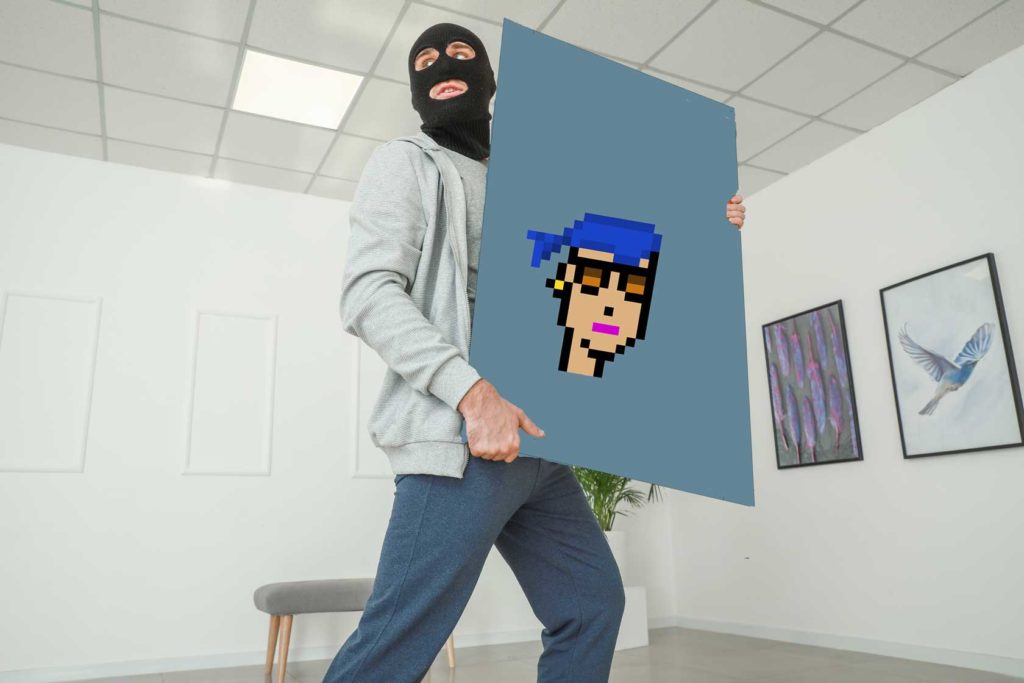A Rembrandt was heisted from the Montreal Museum of Fine Arts by armed gunmen in 1972 along with 17 other paintings. The Concert, by Johannes Vermeer, worth $250 million by it’s last estimate in 2015, considered to be the most valuable stolen object in the world, was stolen from the Isabella Stewart Gardner Museum in 1990.

There is something god awful about stolen artwork.. and something undeniably romantic about it as well.
Of the myriad artworks that live on the Ethereum blockchain, many of them are valued way over a million dollars, and if they were stolen we would probably see headlines about it.
One of the biggest travesties of stolen artworks is that they are removed from society, and no one gets to see them anymore.. until now. The blockchain based technology powering the Ethereum network makes it so that thieves can showcase stolen NFT artwork with impunity. This changes everything about stolen artwork.
Artist’s Creation Address
As an artist, when you mint an NFT, the transaction that creates your new token will be recorded forever and ever on Ethereum’s ledger, and there will never be a question as to who created the token, that’s one of the best things about NFTs.

Now let’s say you are super successful in a year or so, and as your older artworks are seeing explosive gains on the secondary market, your fans are banging down your door to mint more tokens. You’re going to have to create some more tokens, angry art aficionados are the worst, I know because sometimes I am one.
If you don’t have access to the address that you minted those tokens on, if it’s somehow lost or compromised, or if you never wrote down your seed phrase for whatever reason, you will have lost your most important asset (outside of your talent) as an artist.
While you may be forgiven in the short term for minting on a new address by your loyal collectors and fans, your newer tokens simply won’t have the same brand power as your older ones, and while we haven’t seen this phenomenon yet, I’m sure it will be a topic of conversation someday. With a “Don’t trust, verify” mindset, the blockchain community may forever harbor some doubt for an artist minting from a new address.
How Your Artwork is Stored
Whether you’re using SuperRare, Foundation, Rarible or another online crypto art exchange, your art that you have collected is stored in your own wallet, which you are solely responsible for. These exchanges peek into your wallet in order to show the works that you have collected or created, but it’s important to understand that they do not have control over them, only you do.

The only time you are giving access to your token over to these exchanges is when you list it for sale. In order to do this you will need to send it over to their escrow wallet, but even at this point you’re still operating with minimal trust in the service that you’re listing with, because all the transacting is handled by smart contracts, and while I won’t get into the complexities of smart contracts, take solace in the fact that they are publicly audited, and handle the details of your transactions automatically. As of the writing of this article, while smart contracts have been hacked in DeFi (decentralized finance) and other applications, there has never been such a mishap with NFT artwork, as the smart contracts responsible for these types of transactions are very simple, and require only a few lines of code.
Keeping Your Collection Secure
This is the same as keeping your Ether secure, as it lives on the same address. In terms of security there is no difference between your Ether (or any other ERC-20 token that you hold on your Ethereum address) and your NFTs. I like this article that gets into more detail about keeping your Ether secure, you should give it a read and make sure you aren’t making mistakes that lead you to be the target of the world’s first famous NFT art heist.